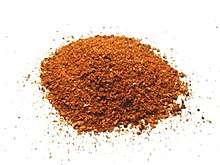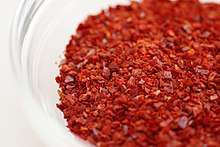Chili powder
Chili powder (also spelled chile, chilli, or, alternatively, powdered chili) is the dried, pulverized fruit of one or more varieties of chili pepper, sometimes with the addition of other spices (where it is also sometimes known as chili powder blend or chili seasoning mix).[1] It is used as a spice (or spice blend) to add pungency (piquancy) and flavor to culinary dishes. In American English, the spelling is usually "chili"; in British English, "chilli" (with two "l"s) is used consistently.
Chili powder is used in many different cuisines, including American (particularly Tex-Mex), Chinese, Indian, Korean, Mexican, Portuguese, and Thai. A chili powder blend is the primary flavor in American chili con carne.[1]
Varieties
Chili powder is sometimes known by the specific type of chili pepper used. Varieties of chili peppers used to make chili powder include Aleppo, ancho, cayenne, chipotle, chile de árbol, jalapeño, New Mexico, pasilla, and piri piri chili peppers. Gochugaru is a variety used in Korean cuisine traditionally made from sun-dried Korean red chili peppers known as taeyang-cho, with spicier varieties using Cheongyang peppers.[2] Kashmiri chili powder is bright red, but mild in heat and used in and Indian cuisine, named after the region of Kashmir.
- Chili powder varieties

- Ancho chili powder
 Piri piri powder
Piri piri powder.jpg) Indian chili powder (from red chilis)
Indian chili powder (from red chilis) Gochugaru (Korean chili powder)
Gochugaru (Korean chili powder)
Blends
Chili powder blends are composed chiefly of chili peppers and blended with other spices including cumin, onion, garlic powder, and sometimes salt.[3][4] The chilis are most commonly red chili peppers; "hot" varieties usually also include cayenne pepper. As a result of the varying recipes used, the spiciness of any given chili powder is variable.
The first commercial blends of chili powder in the U.S. were created by D.C. Pendery and William Gebhardt for this dish.[5] Gebhardt opened Miller's Saloon in New Braunfels, Texas. Chili was the town's favorite dish. However, chili peppers could only be found at certain times of the year. Gebhardt imported some ancho peppers from Mexico and ran the peppers through a small meat grinder three times and created the first commercial chili powder, which became available in 1894.[6]
See also
References
- Farrell, K.T. (1998). Spices, Condiments and Seasonings. Chapman & Hall food science book. Springer US. pp. 215–217. ISBN 978-0-8342-1337-1. Retrieved February 20, 2018.
- Smith, Kat (March 8, 2017). "Gochugaru: The Hot, Sweet, Smoky Red Pepper Powder That is the Taste Behind Many Korean Foods". One Green Planet. Retrieved July 28, 2017.
- Brown, Alton (August 18, 2004). "AB's Chili Powder Recipe". Good Eats. Food Network. Archived from the original on October 13, 2007.
- Bradshaw, Eleanor (June 1997), How to Make Your Own Chili Powder; or, Some Like it Hot, Texas Cooking Online, Inc., retrieved September 11, 2007
- DeWitt, Dave; Gerlach, Nancy (2003), "Chili Conquers the U.S.A.", The Great Chili con Carne Project, Fiery-Foods.com, archived from the original on September 15, 2007, retrieved September 11, 2007
- Massey, Sarah (March 1, 1997). "Man Who Invented Chili Powder". The Pierian Press. Archived from the original on December 28, 2019. Retrieved August 25, 2011.
External links

